Why customer retention is the ultimate growth strategy
If you want to grow in a scalable and profitable way, look beyond customer acquisition.
If you want to grow in a scalable and profitable way, look beyond customer acquisition.
These are uncertain times for any business.
Maybe you’ve seen your top of the funnel demand decreasing. Or your sales cycles are getting longer. While each company feels the impact differently, one thing is certain – businesses are being forced to adapt to change at a pace we haven’t seen before.
When the stakes are high, it can be tempting to invest in short term solutions to help grow your business.
But more often than not, the most effective solutions to short-term problems are long-term solutions. A band-aid is of no use to a broken arm.
One strategy we’ve found particularly useful in trying times is doubling down on customer retention.
This isn’t a new insight. In the last five years alone, the cost of customer acquisition has increased by over 50%. The challenging unit economics faced by companies like Blue Apron and Homejoy has issued a cautionary tale to businesses - if you want to grow in a scalable and profitable way, you have to look beyond customer acquisition.
Businesses have gradually started to switch their focus from “How do we acquire more customers?” to “How do we retain the ones we already have?”

The math to back this up is pretty compelling.
After five years, a company with 2.5% churn is 50% (yes 50%) larger than the company with 5% churn on a revenue basis.
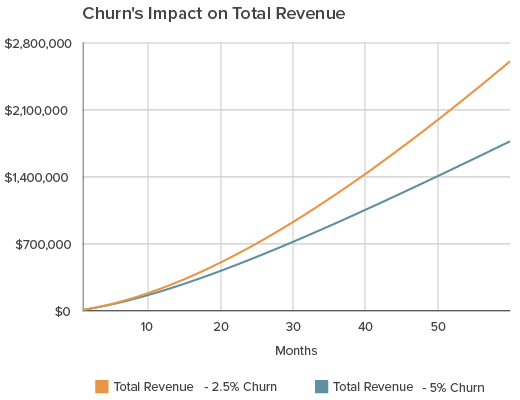
Caption: If you want to model this for yourself, check out this calculator
Put it another way, it just doesn’t make sense to fill a leaky bucket.
At Segment, we’ve helped hundreds of our customers to analyze their user behavior, predict churn, and build profitable, long-lasting businesses. We've also worked incredibly hard to improve retention in our own product over the years.
So we thought it would be helpful to share a handful of our most successful strategies, with some recommended tools to help. (all of which are available in the Segment Catalog)
Thank you to Eleanor Dorfman, Matt Smidebush, Brooks Taylor, Katie Rovelstad, Tyler Goerzen, Alan Harris and Kevin White for their feedback on this article, and for their tireless work in driving adoption of Segment.
Before getting into tactics, let’s spend a minute thinking about how to measure your retention.
When getting started with retention, the obvious first step might be to look at exit surveys or recently churned customers. It might sound counter-intuitive, but this is actually the wrong place to start.
Instead, look at your best customers.
Why did these customers stay with your product? Why did they expand their usage of your product? What actions did they take in your product? If you can figure out what and why, you can start to reverse-engineer that path for other users.
You’ll often hear these referred to as “activation metrics” or “aha moments”. The canonical example is best illustrated by Chamath Palihapitiya and the early Facebook growth team. They understood what actions separate their best customers from those they lost – namely those that added 7 friends in 10 days.
To understand this at Segment, we use a logistic regression model, which combines different dimensions (computed over a week of activity) to form a single raw score. This score indicates how “activated” a customer is, and subsequently how likely they are to retain.
The five measures we track (using Segment, of course!) are as follows:

Start tracking these key retention measures with Segment 👉
A prototypical “good” customer and their workspace connects 1 source, 1 destination, has data flowing, and has sent track and identify calls. This customer has a score of 4.41.
This number then increases or decreases based on additional actions.
When a workspace adds another teammate, their raw score goes up to 5.8 and the chances of them retaining increases further still.
Similarly, if a customer stops taking a certain action, their score and likelihood of retaining decreases.

If you don't have the resources to run a logistic regression analysis like this, don’t worry. You should be able to uncover these high-value actions by running a cohort analysis, or simply by running a series of customer interviews.
Whatever method you use, an analysis such as this will help you understand the behaviors that, when performed, best correlate with users continuing to use your product for an extended period of time.
And once you understand these behaviors, you can optimize your product or communication to help even more users take these actions, see value from your product and ultimately become a long-term, happy customer.
Now that you’ve got a handle on some of the data behind your retention, it's time to come up with creative ideas for improving it.
When we think about retention, it helps to conceptualize retention by breaking it down into three stages—early, middle, and late.
We learned this way of thinking from Brian Balfour, the former VP of Growth at Hubspot and CEO of Reforge. If you are getting started with retention, we highly recommend you watch this talk.
Most products see a precipitous drop in engagement in the first few days. Those that don’t – Facebook, Twitter, Pinterest – do so by making sure users complete valuable product actions early on.
At Segment, the first action that heavily correlates with customer retention is when a user starts sending data into Segment. Here’s a simple in-app message we send through Intercom to nudge users to that action.

The important thing to measure here isn’t opens and clicks, but conversions. In this example, the conversion (i.e users who got data flowing to a source after this message) was 54%. Not bad!
Tools you can use to help:
One a user has completed your product’s high-value actions, watch for decreases in overall product usage. Are they logging in less than they had before? When they are logging in, are they spending less time inside your product?
When doing this, it’s important to look at engagement, not just activity. I like how Lincoln Murphy puts it: “What many SaaS providers would believe is an ‘active’ user…is really a huge, ugly churn threat.”
A user might log in at the same frequency and even spend the same amount of time in your product, but all the while, they’re using the most valuable features less and less.
We recommend measuring retention based on whether users come back to your app and perform your high-value actions.
For example, we use Segment and a data visualization tool like Tableau to look at how many sources and destinations are being connected by customers month over month.
If we notice these numbers trending downwards, like in the below screenshot…

We send proactive communication to the cohort in question before it’s too late. (Talk with a Segment team member to enable this use case for yourself 👉)

Tools that’ll help:
The legendary Don Dodge once said there were two types of products in this world. "Vitamins" are products that are nice to have. “Painkillers” are the products you couldn’t live without.
Understanding and communicating the value your product solves is the key to converting your product to convert from a "vitamin" to a "painkiller".
One of our favorite tactics here is to clearly show the ROI your product is having to their organization. In doing so, you will prove that your product is a vital part of keeping their business running.
At Segment, we like to send monthly newsletters to our users that aggregate usage stats of the product, but critically, also show the quantifiable impact Segment is having.
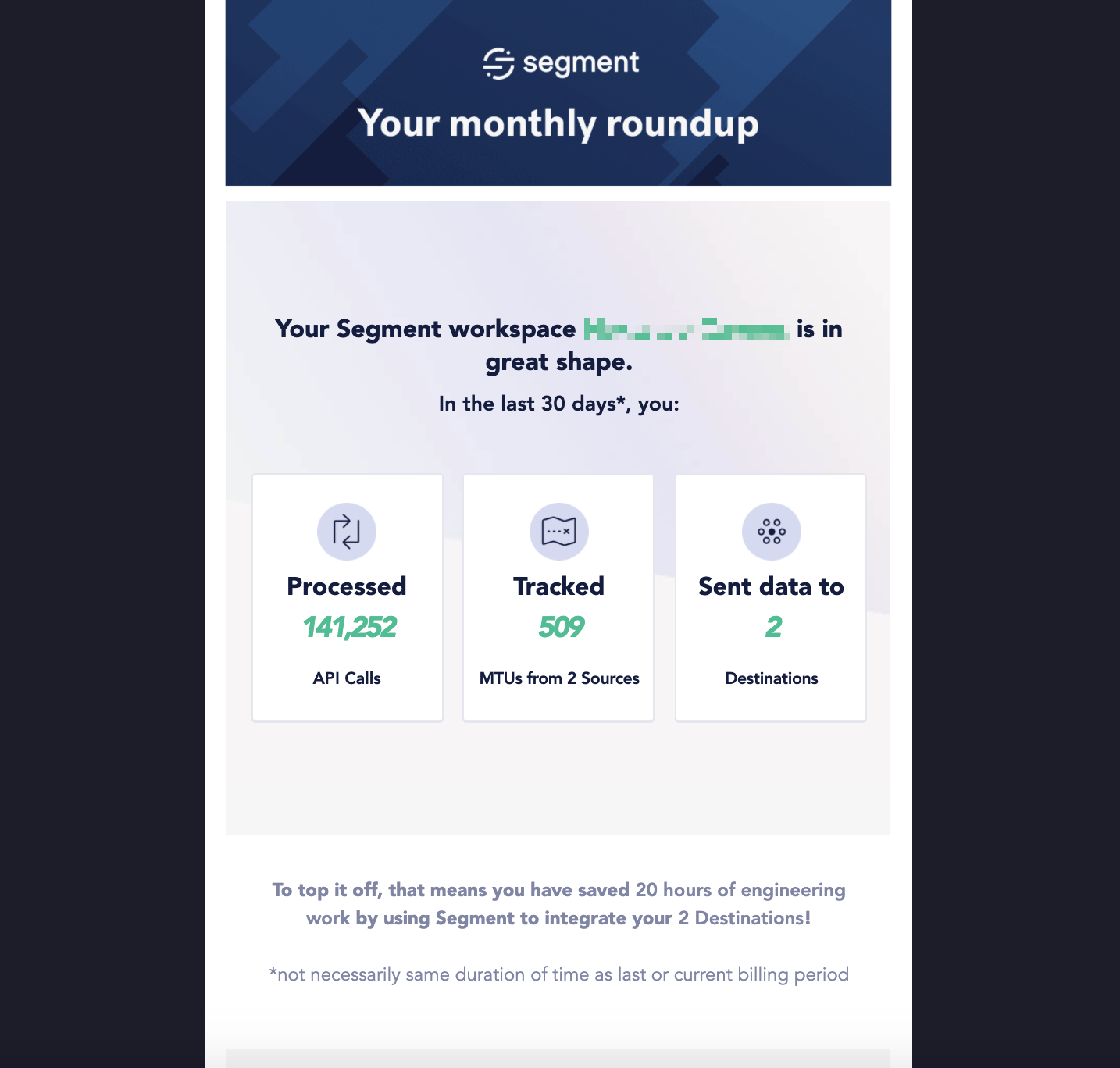
ROI with your product will look different depending on the individual (i.e for a B2B product, a buyer and practitioner may have a different measure of success). Adjust your messaging accordingly!
One of the (many!) positive outcomes as a business sees from Segment is saving engineering resources.
So we use a personalization/scripting language called Liquid (open source from Shopify), Segment’s SQL traits, and Customer.io to dynamically calculate and communicate those positive outcomes to customers.
Here’s the formula we use if you want to swipe it for your own use.
{% capture fun_fact %}{% if status == "habit" %}To top it off, that means you have saved <strong>{{ dest | times: 10 }} hours of engineering work</strong> by using Segment to integrate your <strong>{{ dest }} Destinations</strong>!{% else %}On average, teams that use Segment save <strong>36 hours of engineering work</strong> per year for each enabled Destination. Time to start saving you some time!{% endif %}{% endcapture %}
Tools that’ll help:
During the sales process, reps traditionally try to find the “champion” in a company. This is the person willing to fight through obstacles to adopt a new product and implement change at the organization.
While it’s incredibly powerful to have someone fighting for you in your corner, there is an inherent risk attached – if the champion is the only person to advocate for you, what happens when they leave?
In engineering, this is known as the single point of failure. If a single part of the system fails, the whole system breaks down.
Retention is no different.
To combat this, we use a tool called Vitally, a customer success platform that ingests all your customer data – Segment traits and events, conversations, subscriptions, and NPS scores – into 360° profiles to let you proactively monitor the health of an account.

What’s particularly neat about Vitally is the ability to push data in and out. This lets you easily build custom workflows that help you stay on top of retention.
For example, we have a workflow that pushes data from Salesforce -> Sifdata -> Salesforce -> Segment -> Vitally to alert the assigned customer success and sales rep when we notice an important person left the company.
Unlock this workflow with Segment 👉
Tools that’ll help:
Have you ever tried to cancel Amazon Prime? Up to 5 pages long and featuring multiple calls to action, it’s scientifically engineered to make churn a last resort.
Some of these tactics stray into the dark side of UX, the level of craft shows you why a well-designed cancellation flow is so important. In fact, Headspace found that optimizing their cancellation flow helped reduce churn by up to 10%.
A quick win is tackling involuntary churn. Accidental cancellations or missed payments account for a significant percentage of churn. How significant? At Segment, non-payment can account for anywhere between 10-50% on a weekly basis.

The answer here is pretty simple: track the data and remind them to pay!
You can track the payment events in Segment, using an event such as the below:
analytics.track('Payment Failed', {
plan: 'Business',
cycle: 'Monthly',
expires: new Date('2020-04-15T00:00:00.000Z'),
revenue: 120
});
And then create an automated email to remind users whose payments are overdue, or whose credit card is expiring. As these are transactional emails, keep personalization simple – the amount due, or the final four digits of the card that’s expiring.
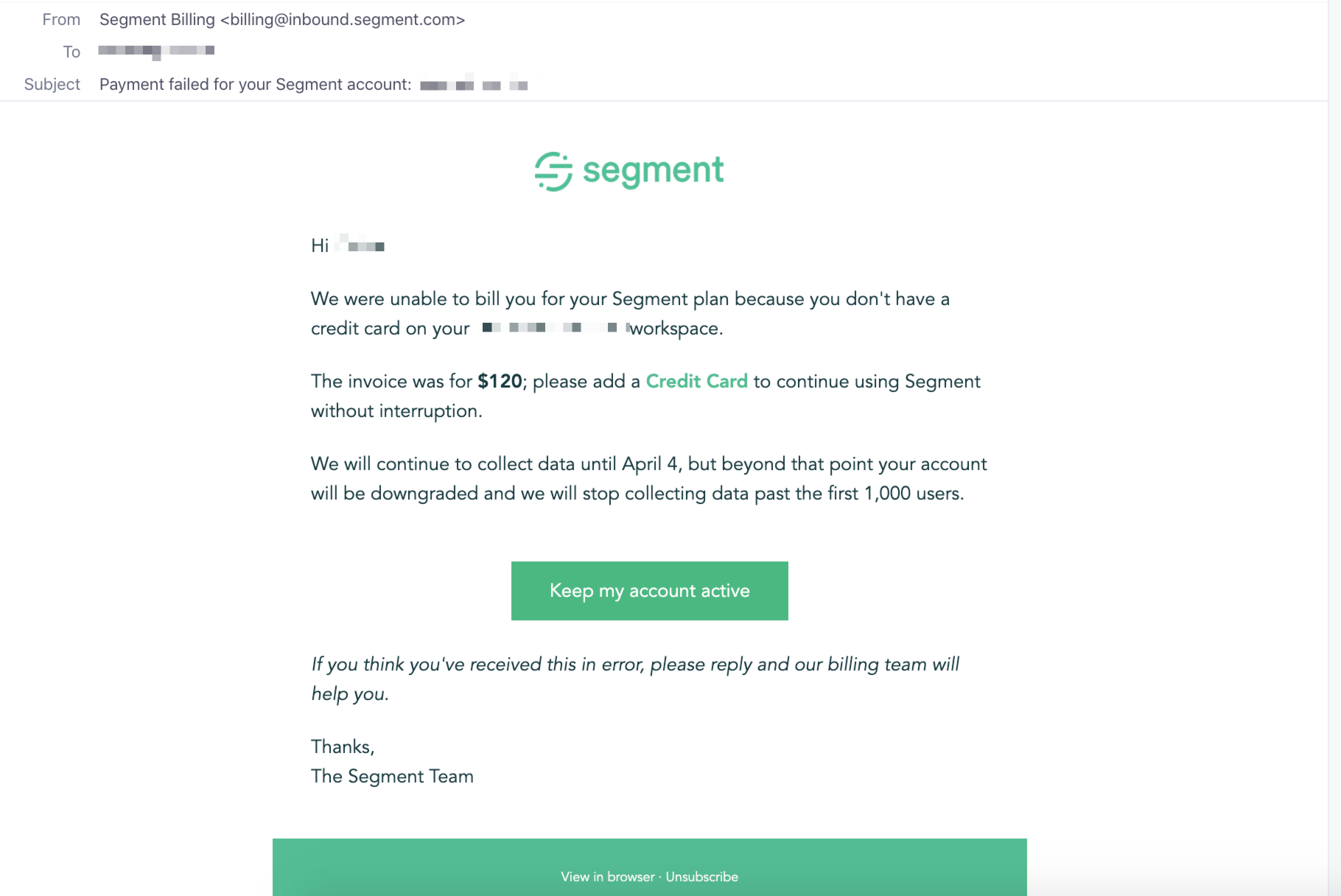
When optimizing your cancellation flow, please bear in mind that any customers “saved” should still be considered very much at risk for churning. This should be the first step in trying to bring a customer back in from the cold, not the last.
Optimize your cancellation flow with Segment 👉
Tools that’ll help:
Churn is a natural byproduct of any business. Customers come and go, as does the demand for your product.
Though it may be painful, make sure you have a well-considered exit ramp. Acknowledge the reasons they’re churning, address them, and make sure they leave endeared towards your company.
At Segment, we recently implemented a churn survey to get a deeper understanding of why our customers are churning and the magnitude of these issues.
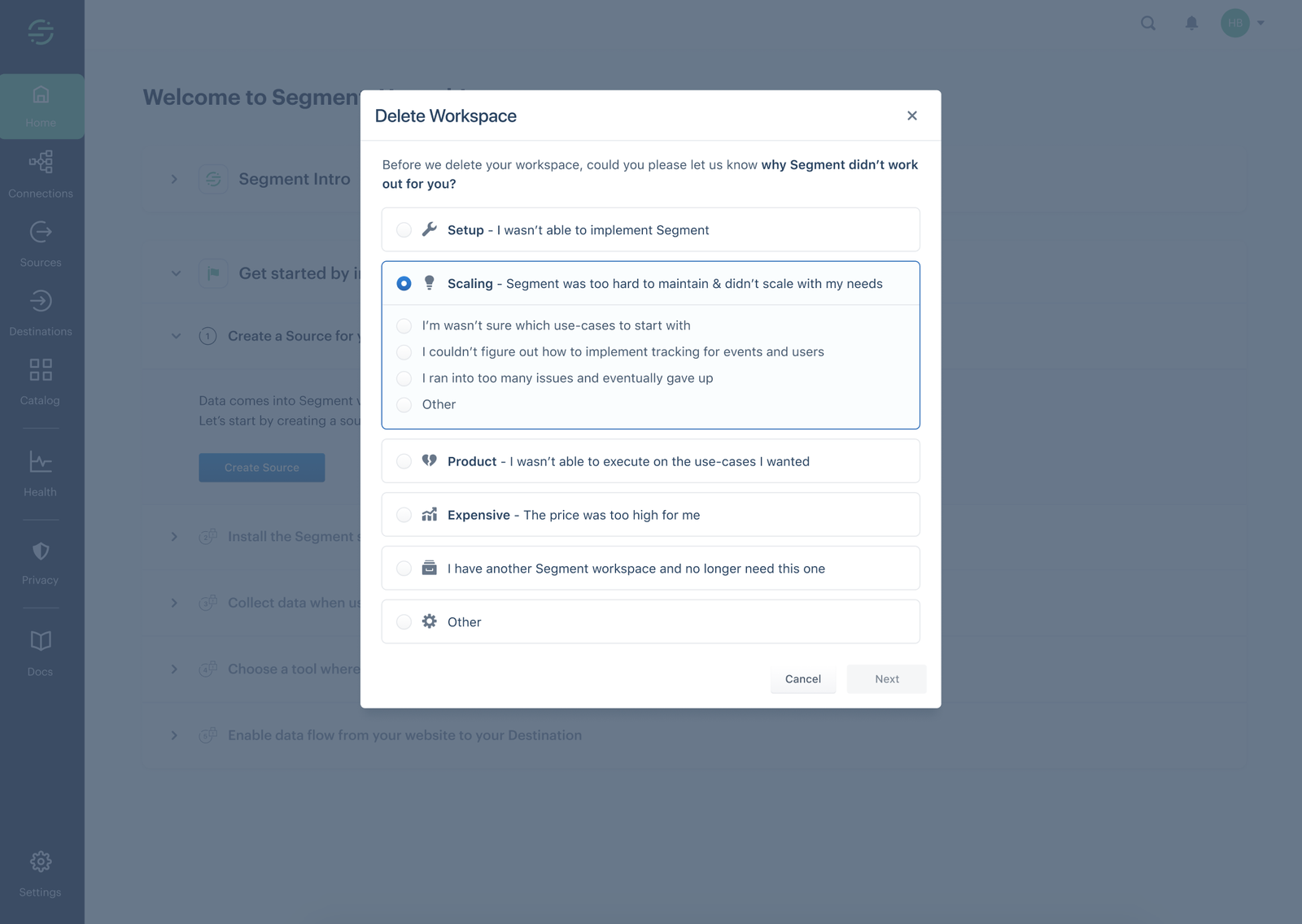
You can use this data to either a) reclaim churned users or b) identify cohorts who are especially prone to churn, so you can get ahead of it.
We send our survey data via Segment first to Slack, to help give folks a reminder about what accounts are churning and why.
:( Churn Alert -- johndoes churned by downgrading to developer
Churn Reason: “Segment was too hard to use”
Any additional Feedback? “I wasn’t sure where to start”
User: John(john@does.com)
Activation level: 2 sources / 3 destinations / 3,000 MTUs
Link to Vitally: segment.vitally.com/johndoes
And then to our email tool, customer.io, where we send a personalized email to every account that churns.
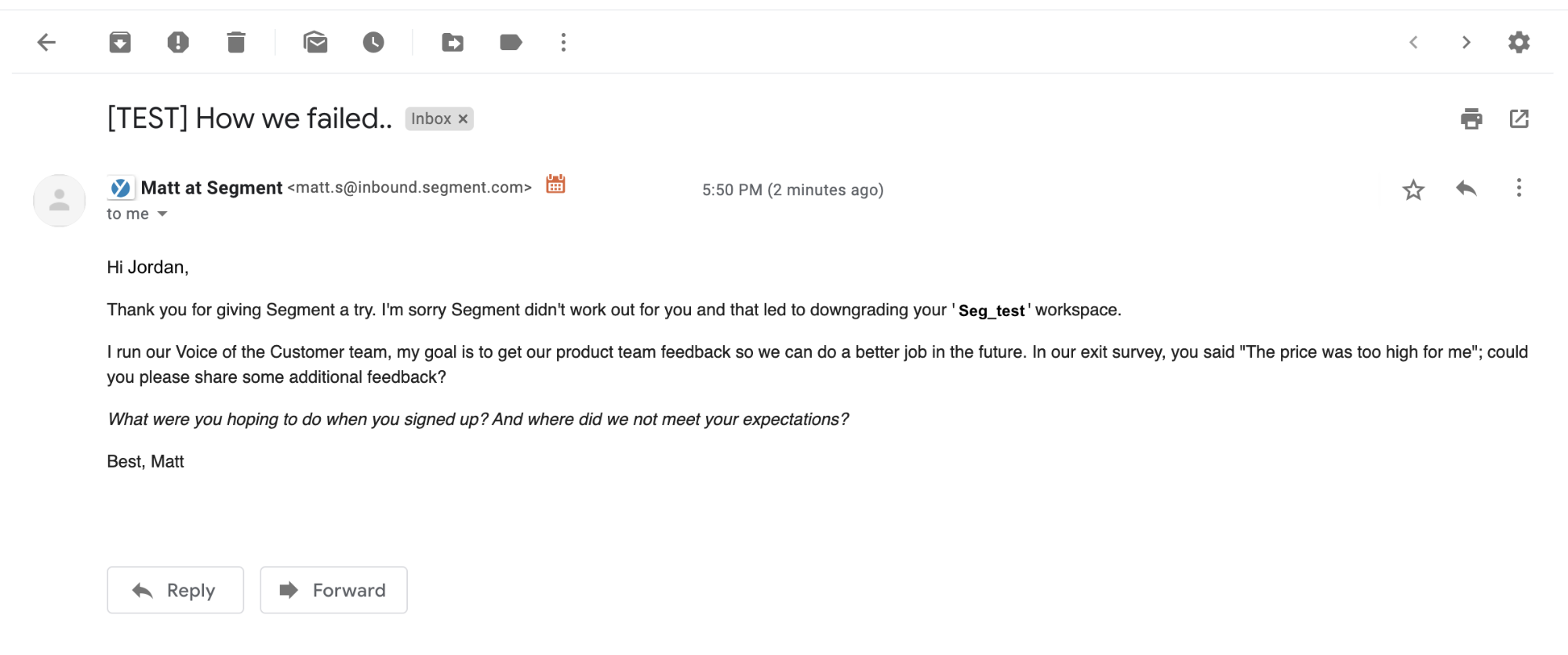
Best case scenario, you’ll open the lines of communication for a winback in the months ahead. But even if that’s off the table, you’ll get valuable insights you can use to help improve your product.
Tools that’ll help:
If you’ve found deal flow and signed contracts to be slowing, there is one area where your business isn’t lacking – data.
You have access to a trove of data you can use to understand what your users need right now. Apply these insights to not only improve your product but also promote trust. Your success is your users’ success, and now is the time to prove to them you’re with them through thick and thin.
By the end of all this, you’ll have a less leaky bucket that can weather just about any storm.
(P.S. If you want help with anything covered in this post, we've got you covered! Get started with Segment here 👉)

Our annual look at how attitudes, preferences, and experiences with personalization have evolved over the past year.